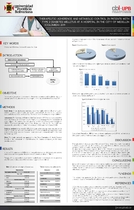| dc.contributor.author | Martínez Domínguez, Gloria Inés | |
| dc.contributor.author | Martinez Sanchez, Lina Maria | |
| dc.contributor.author | Rodríguez Gázquez, Maria de los Ángeles | |
| dc.contributor.author | Jiménez Jimenez, Juan Guillermo | |
| dc.contributor.author | Lopera Valle, Johan Sebastián | |
| dc.contributor.author | Agudelo Vélez, Camilo Andrés | |
| dc.contributor.author | Vargas Grisales, Natalia | |
| dc.coverage.spatial | Seccional Medellín. Universidad Pontificia Bolivariana. Escuela de Teología, Filosofía y Humanidades. Facultad de Filosofía | spa |
| dc.date.accessioned | 2013-07-18T20:13:48Z | |
| dc.date.available | 2013-07-18T20:13:48Z | |
| dc.date.issued | 2013-07-18 | |
| dc.identifier.uri | http://hdl.handle.net/20.500.11912/763 | |
| dc.description | Poster presentado en evento internacional | spa |
| dc.description.abstract | The achievement of therapeutic goals, is of great importance in patients with chronic diseases such as diabetes mellitus (DM), because of its impact on morbidity and mortality. Objective: to explore the relationship between therapeutic adherence and metabolic control in patients with DM-2, who were seen at a hospital in the city of Medellín (Colombia). Methods: cross-sectional study involving patients with the following selection criteria: age ≥ 18 years, diagnosis of DM-2 ≥ 6 months, who signed informed consent. The Summary of Diabetes Self-Care Activities (SDSCA) score was applied for the measurement of therapeutic adherence and Duke-Unc score for the assessment of perception of social support. Glycosylated hemoglobin (HbA1c) was processed by turbidimetric inhibition immunoassay (TINIA) Cobas C-501 equipment. Adequate metabolic control was defined as value of HbA1c ≤ 7%. Version 19.0 of the SPSS program was used for the statistical analysis. Results: 70 patients studied: 66% are female, 76% suffer from hypertension, 70% have dyslipidemias and 16 % smoke. In addition, 59% are insulindependent, 70% have inadequate glycemic controla and 87% has no social support. Items with the highest proportion of adherence were: medication (79%), foot care (71%) and diet (62%). Whereas the lowest were: HbA1c (32%) and exercise (28%). HbA1c correlated significantly (p < 0.05) with adherence to diet, blood glucose monitoring, foot care, social support and sex. Conclusion: therapeutic adherence was associated with metabolic control in patients with DM-2. | spa |
| dc.language.iso | en | |
| dc.subject | Medication Adherence | spa |
| dc.subject | Diabetes Mellitus | spa |
| dc.subject | Self Care | spa |
| dc.title | Therapeutic adherence and metabolic control in patiens with type 2 diabetes mellitus at a hospital in the city of Medellín (Colombia) 2011 | spa |
| dc.type | other | spa |
| dc.rights.accessRights | openAccess | spa |

